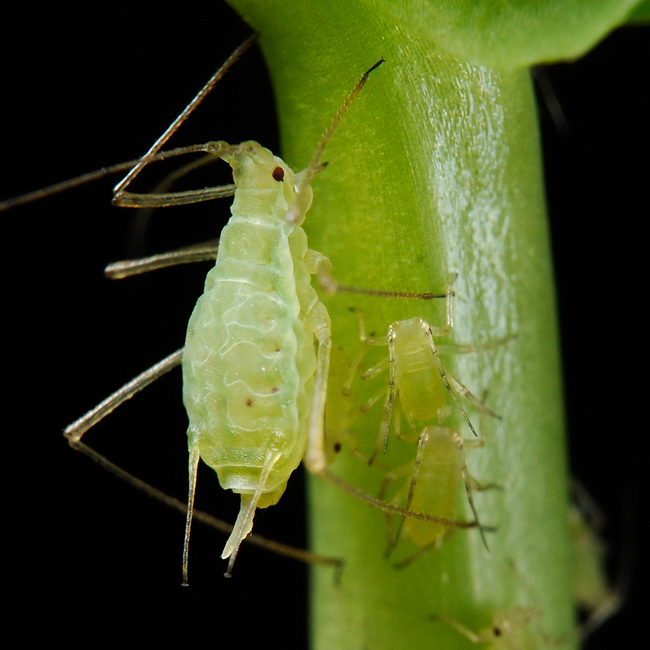Aphids are the most common pests found in your garden. These sap-sucking creepy crawlies are regularly seen bolstering in bunches on new plant growth. They suck the fluids from leaves and flowers that the plant uses to distribute nutrients, which turns the leaves a mottled yellow color and stunts growth. Aphids swarm both gardens and farms, and on the off chance that they happen to influence it inside, they to can turn into an issue on houseplants, as well. Let’s discuss what are aphids, what are the symptoms & how to identify aphid damage?

Aphids
Aphids are also known as plant lice. They are the small sap-sucking insects. There are approximately 4,000 aphid species found throughout the world. Most of the aphid species are green, but some species are white, brown, red or black in color. Aphids are small, soft bodied, pear-shaped insects, that have specialized mouths to suck the fluids from leaves and flowers. Adult aphids have antennae, although they may or may not have wings. Generally adults are wingless, but some can grow wings, especially if populations are high, so they can move on to begin a new colony.
Life Cycle
The Aphid life cycle is between 1 week and 40 days. Female aphids give birth to live female nymphs, bypassing the egg stage. Young nymphs increase gradually in size and within a week give birth to many more nymphs. This process is repeated several times and results in huge population explosions.Most aphids, except for the sexual forms, do not have to mate in order to reproduce, and they produce live young, rather than eggs. Fortunately, this rapid reproduction is kept in check by natural predators, environmental factors, and chemical controls.
Identify Aphid Damage
Effective aphid control is essential for the overall health of your organic garden. If certain plant roots are attacked by aphids, the plant may shrivel and die, particularly those of young plants or new growth. Aphids prefer the bottoms of leaves rather than the top, and they are so small they can be difficult to see at a glance. Nymphs and adults feed on plant juices, attacking leaves, stems, buds, flowers, fruit, and/or roots, depending on species. Most aphids especially like succulent or new growth. It’s important to keep a watchful eye on your plants for signs of aphid damage, since the aphids themselves may not be visible.
Symptoms Aphid Damage
Keep an eye out for some of the following indicators:
- Aphids produce a sweet, sticky excretion known as honeydew, and if you notice a substance on your plants that feels sticky, it may mean aphids are living on the plant.
- The honeydew can sometimes develop a fungal growth called sooty mold, causing branches and leaves to appear black.
- There may be an increase in the ant population surrounding an infested plant. Since the aphids’ honeydew is high in sugar, it attracts the ants to the plant.
- Look for misshapen, curling, stunted, or yellow leaves. Be sure to check the undersides of leaves, aphids love to hide there.
- Flowers or fruit can become distorted or deformed due to feeding aphids.
- Some aphid species cause galls to form on roots or leaves.
- Aphids may transmit viruses to certain plants, and also attract other insects that prey on them, such as ladybugs.
Damage Caused By Them
Here are some of the common results of an aphid infestation:
- Aphids can transfer diseases from one plant to another.
- Plants may stop growing or have yellowing leaves.
- If certain plant roots are attacked by aphids, the plant may shrivel and die, particularly those of young plants or new growth.
- Aphids deplete the plant’s fluids and nutrients from all parts, including leaves, stems, new growth, and flowers, so plant growth may also be impacted.
- Aphids tend to colonize on new growth and flower buds, so, flowers, buds, or new growth may appear stunted, distorted, or otherwise unhealthy.
- The presence of honeydew may encourage the growth of fungi, such as sooty mold fungus and others which can cause further damage to your plants.
Aphids Control
To know more about the natural & homemade ways to kill aphids, click here. Here are the few ways to control aphid damage:
- Pinch or prune off heavily infested leaves or other plant parts.
- Try spraying cold water on the leaves; sometimes all aphids need is a cool blast to dislodge them.
- Dust plants with flour. It constipates the pests.
- Use commercially available biological aphid controls or by spraying with insecticidal soap or horticultural oil.

Great article.. Keep it up